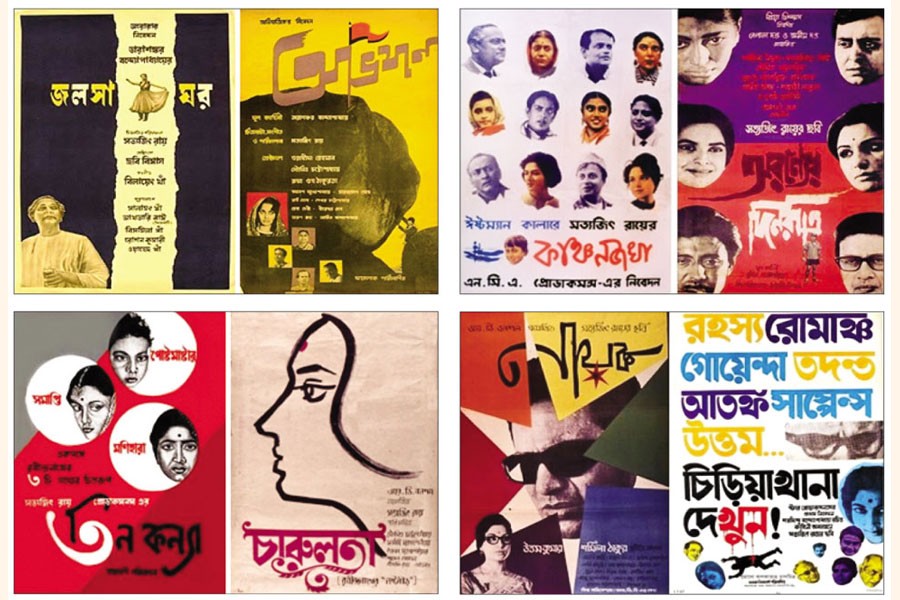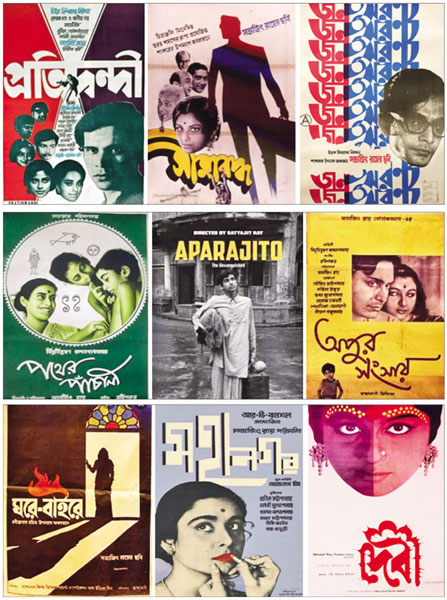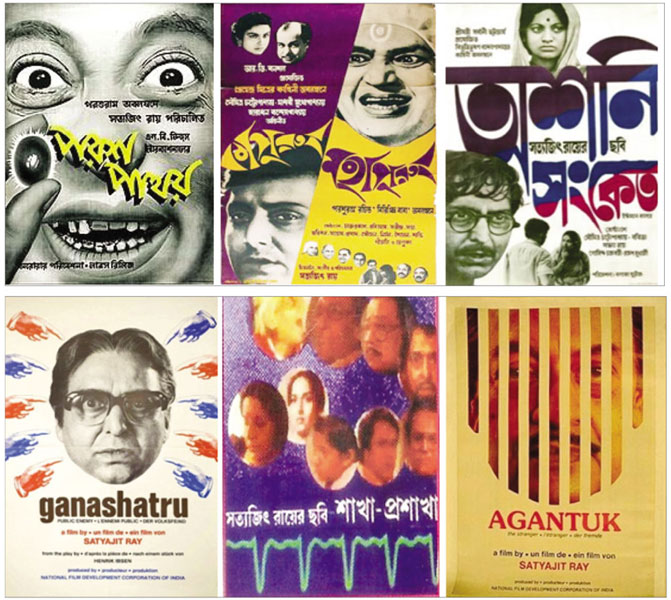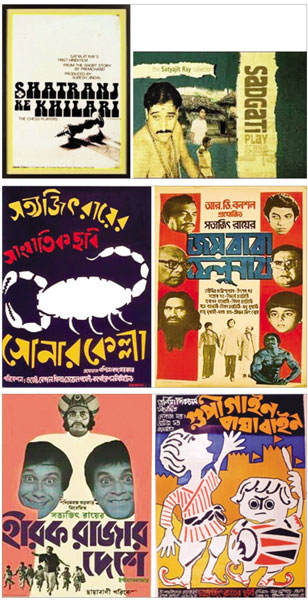
 Satyajit Ray is the name of the world’s one of the greatest auteurs. His incantation had endured in Tollywood for almost four decades. But he is being remembered decade after decade in every heart that has come across.
Satyajit Ray is the name of the world’s one of the greatest auteurs. His incantation had endured in Tollywood for almost four decades. But he is being remembered decade after decade in every heart that has come across.
Though Ray was a Bengali living in Kolkata, his ancestry was from Kishoreganj district of Bangladesh. Ray visited Bangladesh by a steamer in the Padma with his mother as a little boy aged 5 or 6. He paid a visit to his maternal uncle who lived in Dhaka’s Wari then. Later after independence, he once again visited Bangladesh as the chief guest on the occasion of our ‘Shaheed Dibosh’ on February 21 in 1972. There this Bengali was overwhelmed by the love of Bangladeshis.
If we gauge Ray’s cinematography, music composition, story-telling and even the film posters were idiosyncratic. Being a fine arts student of Visva-Bharati University of Santiniketon, Satyajit was apt in art. His direction in films, art-direction and all else from make-ups to costume to posters took the movie industry to a whole new level. His each and every work was highly acclaimed both nationally and internationally.
 40 years of work brought Satyajit Ray the honour of being 13th in BBC Bangla’s ‘Greatest Bengalis of all time’ list. Because of his works, masses outside the Bengal-speaking region got to know the Bengali language and its depositories. Ray is always remembered as a pioneer of Bengali cinema in the world of Bengali literature and arts.
40 years of work brought Satyajit Ray the honour of being 13th in BBC Bangla’s ‘Greatest Bengalis of all time’ list. Because of his works, masses outside the Bengal-speaking region got to know the Bengali language and its depositories. Ray is always remembered as a pioneer of Bengali cinema in the world of Bengali literature and arts.
We all have watched Ray’s movies or went through his far-famed ‘Feluda Shamagra’ and other works. But less is known about this prodigy’s movie posters. One must know Satyajit Ray designed many of his film posters. He gave equal importance to poster designing unlike any other activities of film production.
What is a film poster: Posters are often seen before a movie is released. Just as book covers, film posters are the frontispiece of a film. They are an initial image of the film, a summarisation of the 2-hour full-length picture. As we know, an image has language; an image can be read—a poster is a fine example of it. People catch visual a lot more than a write-up. They like mystery, camouflage and veiling of the story under the end of a thread. And to solve this riddle, viewers eventually choose to watch the film.
So, a poster is made up with some key elements of the movie which says a lot except the climax. It sparks an interest in the audience and has the power to drag anyone to a theatre to watch the whole film. Satyajit Ray, in his time, was an acclaimed name of poster designing. His every film’s poster is a bearer of this maestro’s uniqueness. He felicitated posters with art, artifice and artfulness. His film posters brought a new dimension to the Bengali movie industry.
Ray’s posters, whether designed by him or others, were always perplexing and intricate, decidedly quirky. His dexterity in art made him inimitable in poster designing. Any whip-smart will get connected to his posters. Among myriad works of the great man, let us go through some posters of Satyajit Ray-directed films.
Apu trilogy posters
 Satyajit Ray’s highest award-winning films are Apu trilogy’s one. The movies have three similar yet different posters spreading a homey vibe. His first film Pather Pachali’s poster was designed by him. The circle is the window of Apu’s life. Here a lovely affectionate moment of the mother-child is shown which is partly driven from his childhood memory with his own mother. Sibling bond is also a part of the poster. The fishes and sun is the blazon of puerile.
Satyajit Ray’s highest award-winning films are Apu trilogy’s one. The movies have three similar yet different posters spreading a homey vibe. His first film Pather Pachali’s poster was designed by him. The circle is the window of Apu’s life. Here a lovely affectionate moment of the mother-child is shown which is partly driven from his childhood memory with his own mother. Sibling bond is also a part of the poster. The fishes and sun is the blazon of puerile.
On the other hand, in Aparajito, we see the inquisitive eye of  teenager Apu, standing alone bemused with his baggage in hands.
teenager Apu, standing alone bemused with his baggage in hands.
The last film of the trilogy Apur Shangshar again portrays a family life of Apu with his wife, though there is a younger Apu standing in the corner connecting the past. The handwritten title gives a local cultural touch.
Women-centered posters
The poster of Ghare Baire has a powerful meaning where a woman is standing befuddled thinking to stay in or move out the lintel. The black shadow is inside whereas the bright part shows you the world outside. The chiaroscuro with multicolored door design is another level of the experiment of the prodigy Ray.
In the poster of the film Mahanagar, there is an image of the protagonist Arti applying lipstick on her lips. Very intentionally the colour red is used in lightless desaturated background as an emblem of emancipation.
According to the story, Devi’s poster where the face of Dayamoyee portrayed by Sharmila Thakur is illustrated as a goddess. Her face is showing a split identity—goddess Kali on one side and a human face on the other—making the audiences confused.
If you have noticed, the common feature of this trio is the expressive typography in the title. Ghare Baire has a fire lit-up above the font depicting the bubble over, buildings of a big city are depicted in Mahanagar typography and Devi depicts the temple.
Satyajit’s posters designed on Rabindranath Tagore’s stories
Satyajit Ray constructed two of his films on Rabindranath Tagore’s short stories.
Teen Kanya is directed from three short stories of Rabindranath Tagore—Monihara, Postmaster and Shamapti. The cinema’s poster has the three protagonists’ faces in three circles. Since there are three stories, he kept it diaphanous and distinguished. Three circles with three shades of color are, as if, depicting three consequences.
Just a portrait of the protagonist with blank expression in calligraphic brush stroke says a lot about the movie Charulata. Again, you cannot ignore the ornate typography. The handwritten poster is too artistic.
There are two similarities seen in the letterforms. Both the titles are written in a very pleasant and captivating way. There’s a subtle artifact touch which relates to the traditional sophisticated art forms of Bengal.
Satyajit’s posters designed on Tarashangkar Bandopadhya’s stories
The poster of the movie Jalshaghar is unique with colour combination, typography and images. It is a classic movie portraying the main character with a metaphor in the middle of the title.
The coloured poster of Avijan is another noteworthy creation by Ray. Use of bright yellow colour with an expressive typography title was metaphoric. Again, Satyajit experimented with the cut-out head feature of this poster. Here multiple casts are framed in square and rectangular geometric shapes.
The great Uttam Kumar in posters of Satyajit Ray’s films
Ray’s own designed Nayak poster is the most iconic among all. The stardom of Uttam Kumar in the film is clearly shown in the star-shaped poster of multi-bright colours. The film theme letterform bears a star with the typography.
A poster with other lines than the title can be found in the poster of his film Chiriyakhana where different colours are used and the faces in bubbles are coloured too. Use of colours and attention-seeking words made the poster different from others.
Floating cut-out heads in bubbles
Kanchanjangha was the first colour movie of Satyajit Ray. Here the posters too contain some colour faces of the multiple characters in the movie. The miniature of the Kanchanjangha hill beside the title is the supreme feature of Satyajit Ray.
Aranner Din Ratri has again followed the same technique. The characters are seen with their floating heads and their facial expression tells a lot. But the title is unparalleled with calligraphic brush stroke.
Satyajit’s most extolled Calcutta trilogy Pratidwandi, Shimabaddho and Jana Arannya are the complete series of political prospects. The posters of these three have floating cut-out heads in common, illustrating the tension, depression, questioning expression and the embroiled situation of the then youths of Kolkata. Yet Shimabaddho is different with the protagonist in a fuzzy limb with a suitcase in hand depicting his role played in the movie.
Two Masterpieces in Bollywood
The two Bollywood films Saatranjke Khilari and Sadgati by Satyajit Ray had completely different types of posters. In the 1970s films, theme letterforms were very popular.
Ray’s classic Saatranj ke Khilari is the perfect example of it where the title is designed in chess theme.
Sadgati’s poster has some similarities with Jalshaghar’s poster in division of three columns and colour combinations. The protagonists are seen on the left side whereas an innovation is made with the letterform of the title. The name of the movie is written with a mixture of capital and small letters which is not shown in any other film posters of Satyajit.
Blood-hound Feluda series
Satyajit Ray directed two films from his own-written Feluda series. The poster of Sonar Kella was designed by Satyajit Ray himself. In addition to the title, there is a tagline highlighted in red colour and a crab is used as a metaphor.
The Joi Baba Felunath poster has the cut-out heads of the characters, floating in bubbles and in the middle we can see the trio Feluda, Jatayu and Topse!
Last day films
In the 1980s, the later film posters of Satyajit Ray were much different from his propriety. With multiple primary red-blue coloured fingers pointing at the protagonist in the centre are a complete depiction of the film, Ganashatru.
Shakha Proshakha and his last film Agantuk had the simplest yet powerful posters among his filmography.
Shakha Proshakha has a sinus rhythm below the title as a metaphor.
The poster of Agantuk can be explained as the face of demure unsmiling Manmohan Mitro behind the bars of civilization.
Modern technology had touched the industry by then. All three had the title typography in common. Thick fonts with plain mono colours were seen.
The other posters with each significant feature
Parash Pathor poster has that iconic ‘pathor’ in it. Like the outstanding acting skill of Tulsi Chakrabarty as Paresh Dutt, his expression came out realistic. There is a big text in the face of the protagonist which makes the poster remarkable.
The satirical comedy, Mahapurush and romantic-tragedy Kapurush have a unique expressive typography in fish shape. Influenced by contemporary pop-art, cut-out heads floating like bubbles with multiple characters of the film are a common feature of Satyajit’s posters.
Asani Sangket, the title written following western typography trends, was given much importance signifying the theme of the film. The three shades in black, blue and red were used intentionally to lighten the signal of thunder.
Hirak Rajar Deshe’s poster with bright royal blue bold typography has the protagonists at the front. The letterforms often seem like they are done in sharp diamond cut design.
In the first commercial success of Satyajit, Gupi Gayen Bagha Bain, the child-like poster in cartoon characters secured a special place in the hearts of adults as well as children. The typography with mixed primary colours was eye-catchy.
Satyajit Ray had experimented a lot with his film posters. We see none of the poster designs matches the other. Each poster had some exceptional features like the film. He never compromised with his cinema poster, rather showed much importance and dedication to make every one of them a unique one. Satyajit Ray’s posters are critical yet eye-pleasing as there is always a query in texts and images. A mixture of all can only be found in Satyajit Ray’s work.
Film posters are a key feature of the film production. It’s a challenging part where one has to design a poster with magnetic portions of a film. Grabbing the attention of the passersby is the prime responsibility of the poster. The more attractive the poster is, the more audience it will draw.
There’s fun in showing something but not telling. Because a picture tells a thousand words. It is a marketing technique as well. Through the poster you are providing the clues, the theme but not narrating it. Anybody attracted to the puzzle of your poster will surely go for watching it.
There should be depth in the poster. If it is easy to solve by seconds watching, unfortunately one is losing audience. Just with metaphors the mysteriousness can be manifested. People will explore the poster.
Without speaking, just with texts, style, iconography, typography and depending on the theme of the film a riddle has to be created that pushes viewers to theatre.
Just we can have a glance at the posters of Satyajit Ray which has successfully lifted the value of films.
Cheap-trashy posters can never win hearts. Often now-a-days people fail to attract an audience with posters because of the filthiness of it. Now trailers are considered enough, so film people put less effort in making impressive posters. But posters haven’t lost their dignity. It was and still holds its same place in making a change.
How Ray’s films associate today’s Bangladesh: Satyajit Ray’s films are thoughtful and create social consciousness. He always wanted to tell the stories of the upper middle class, lower middle class and lower class. Class struggles, discrimination, oppression, power, politics, women’s issues, social unrest, unemployment, etc. were seen in Ray’s films. Through his films he unveiled the decayed reality existing in the society. The truth is known to everyone, yet they cannot see it. Ray brought such verity in front of the eyes very astutely.
His films of 1960s-70s are still relevant to today’s circumstances in Bangladesh.
Like the Kolkata trilogy of Ray where we see the unemployment issues in a capitalist society there is a cachet of the then issues prevailing in our society even today. We still couldn’t fend off the unemployment challenge, still we are running after capitalism forgetting its own self.
The dictatorship of ‘maharaj’ in Hirak Rajar Deshe is a political satire that too relates to present day circumstances. We can take Ray’s women-centered movies where superstitions, women lagging behind have been highlighted. This is true in our society even in the twenty-first century. In remote areas, even in big cities, superstition against women, kobiraj or traditional healers are still there in villages. The number of working women has increased to a level but the superstitions have not stopped.
Ganashatru is a story prevailing in every country, every society, and at every corner. Even in this Covid-19 situation, we have got so many examples of people being enemies of the masses because of saying the truth and doing what is needed to be done.
Mahapurush! That too can be in front of us but we follow them heedlessly. They are of no good but the people have no courage to go against the flow. Only a few with immense valor and tactics unmask them.
Asani Shanket bears resemblance to our early pandemic days this year. Besides, Ray’s other films are connected in a way or other to Bangladesh’s perspective.
So Satyajit Ray is still relevant enough to our present-day life. He holds such a position that nobody is that fortunate to match his level.
Ray is a pride of our Bengal. He is the Maharaja!
The writer is currently studying at the Department of Mass Communication and Journalism at University of Dhaka. She can be reached at afranawmi@yahoo.com.
**ALL IMAGES ARE COLLECTED FROM THE INTERNET
© 2025 - All Rights with The Financial Express
